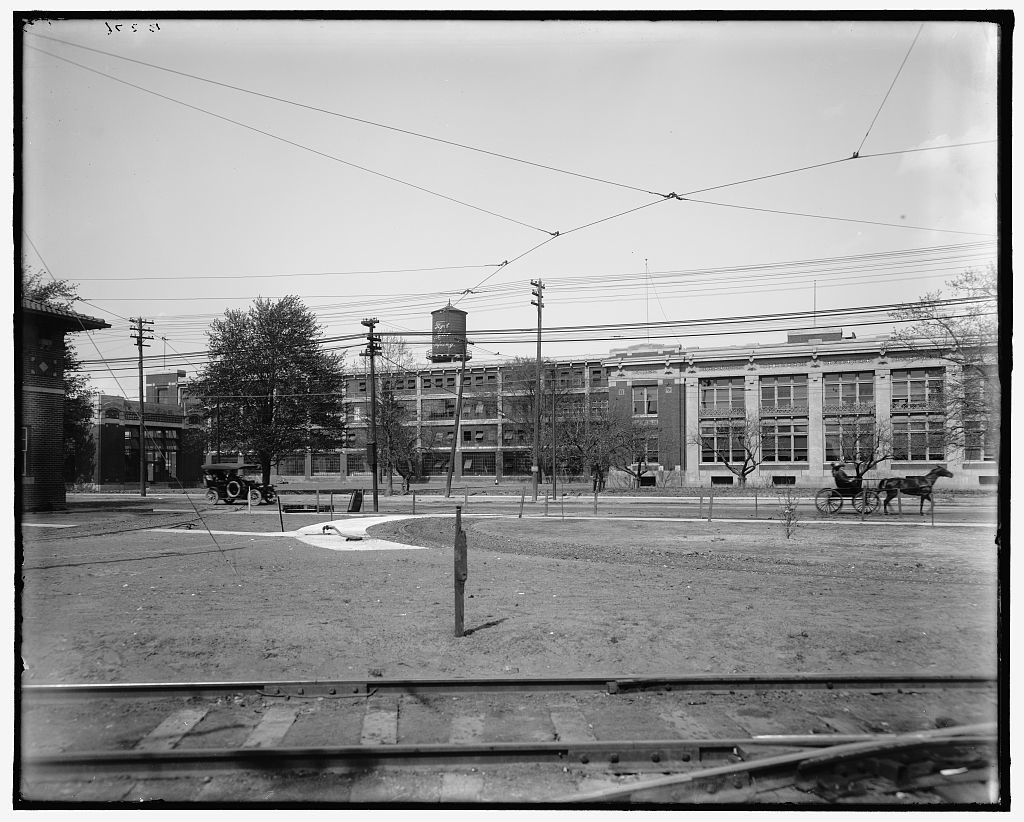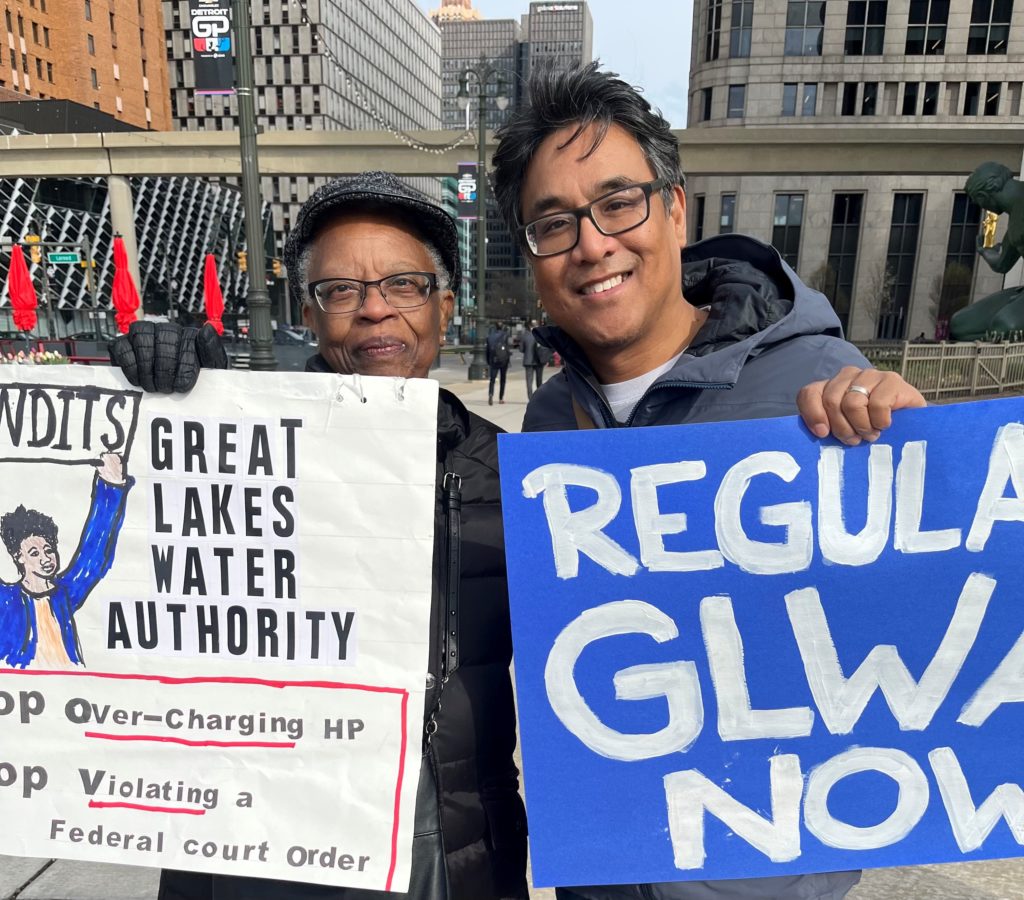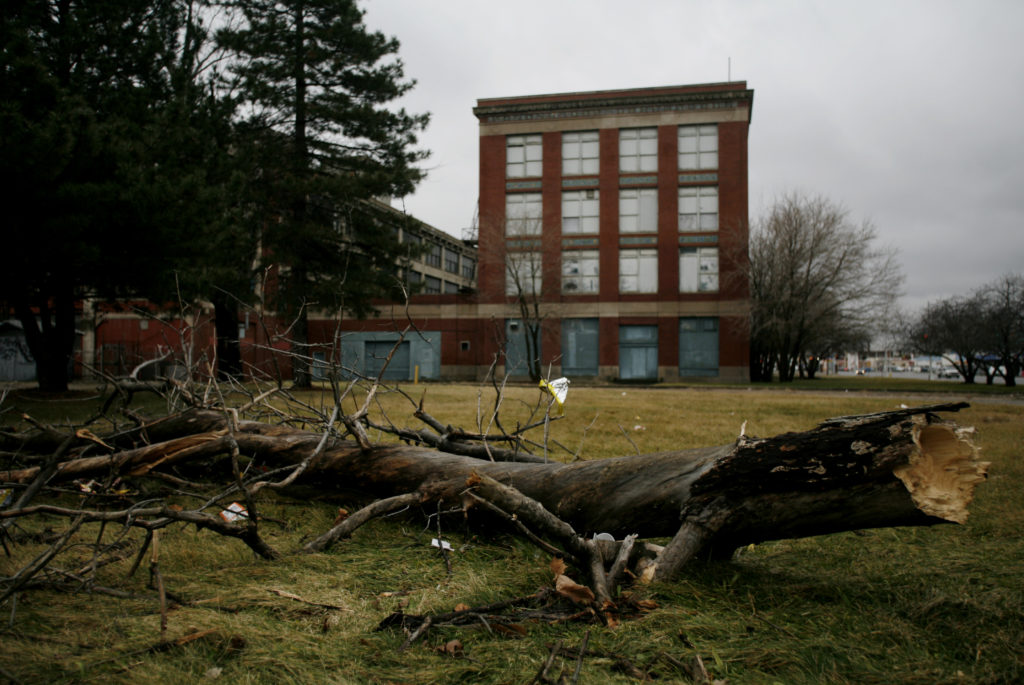How rising water costs could drive this Michigan city to bankruptcy
HIGHLAND PARK, Mich. — Surrounded by some of the largest fresh bodies of water in the country, many Michigan cities still struggle to provide their residents with safe and affordable drinking water.
That irony is especially painful in Highland Park, Michigan, an enclave city surrounded by Detroit, may be facing bankruptcy over tens of millions of dollars in water bills — the costly aftermath of a financial crisis that left residents without a working water plant.
READ MORE: How segregation and neglect left Benton Harbor, Michigan with toxic water
Highland Park Mayor Glenda McDonald asked the city council to approve hiring an attorney to help prepare for its mediation in May over its water debt with the Great Lakes Water Authority (GLWA). When the council did not approve this request, the mayor declared a state of emergency and asked the state to approve an expedited bankruptcy to get their financial affairs in order.
“Highland Park’s annual water and sewer bills of $7,000,000, and growing, are almost as much as our total property tax collections of $9,000,000 per year,” McDonald said in a statement in April.
McDonald also said it is “unjust and unconscionable” for 2,000 households in Highland Park with a median household income (MHI) of $20,000 a year to have a water and sewer bill of $3,500 per household, which amounts to 17.5 percent of MHI. Federal guidelines state that a combined annual water and wastewater bill of less than 4.5 percent of MHI would be considered affordable. But by that yardstick for affordable water and waste services, some Highland Park residents are paying much more.
Highland Park is a Black-majority city sometimes referred to as “Detroit’s Detroit.” The city’s water supply once powered Henry Ford’s Model T factory, but today residents are left fighting for clean and affordable water to drink.

The abandoned Ford School in Highland Park is one of the many abandoned buildings in the small Detroit enclave. In 1907, Ford Motor Co. founder Henry Ford bought 160 acres of land for what would be his Highland Park Ford Plant. More than 50,000 people lived in Highland Park in 1930. Fewer than 9,000 now call it home. (AP Photo/Corey Williams)
Many minority-majority cities struggle with the most expensive — and not always safe to drink — water and the looming threat of shutoffs.
“Local government, even the state, have done a poor job of being able to adequately educate residents about water infrastructure, how it’s paid for, what it takes in order to have safe accessible drinking water come out of your tap,” said Sylvia Orduño, an environmental justice activist who has been an organizer with the Michigan Welfare Rights Organization for more than two decades.
In May, the Michigan Senate passed the budget proposal for the Michigan Dept. of Health and Human Services (MDHHS) that includes $20.3 million to help the city with its water debt. Gov. Whitmer also announced budget recommendations that called for funding for long-term infrastructure needs across the state, like removing and replacing lead service lines, and ensuring the quality and safety of drinking water.
The city and the regional water authority have now begun mediation to figure out exactly how much is owed and how it will pay. An interim agreement was reached in June to pause all court activities from the pending 2014 and 2020 collection cases until October, to continue working toward a comprehensive solution, and for Highland Park to make a $1 million payment.
Powering the world’s first moving assembly line
At its height, Highland Park was home to about 53,000 residents in this suburb built around the automotive industry. The first Chrysler plant predates the incorporation of the city. Henry Ford built his Model T and the world’s first moving assembly line in Highland Park, and when the automobile entrepreneur offered the incredible wage of $5 a day for an eight-hour work day in 1914, workers flocked to the city. With the lobbying and support of Ford, who needed steam to power his namesake company’s assembly lines, Highland Park built its own waterworks in 1915.

Ford Motor Company plant, Highland Park, Michigan, between 1900 and 1920, Library of Congress, Prints & Photographs Division, Detroit Publishing Company Collection.
However, the same companies that contributed to Highland Park’s manufacturing boom started to then leave the city. After building 15 million Model Ts, Ford moved his headquarters and factories to neighboring Dearborn in 1927, where more water and power were available, taking 33 percent of Highland Park’s tax base with him. Ford later tore down large portions of the Ford Highland Park plant in the 1950s, then closed Ford’s last remaining Highland Park tractor assembly line in the 1970s. Competing Detroit Three automaker Chrysler centralized its operations in Auburn Hills, another Detroit suburb, in the 1990s, taking 25 percent of the city’s tax revenue and 6,000 jobs with it. White flight, too, accelerated after Detroit’s 1967 rebellion, and the crack epidemic of the 1980s and 1990s severely affected the city as well.
Today, this 3-square-mile city has a population of 8,657, and it is 85 percent Black, according to 2022 U.S. Census Bureau data. It has a median household income of just over $25,000, and 41 percent of the population lives below the poverty line.
READ MORE: Judge dismisses Flint water crisis charges against former Michigan governor
As Highland Park’s population and tax revenue continued to decline over the decades, emergency management under multiple governors followed. In Michigan, emergency management allows the governor to declare a financial emergency within a local unit of government or school district and appoint an emergency manager to fix it, with more power than elected officials and authority to sell assets, implement cost cutting, and change contracts. The Flint water crisis happened after the emergency manager changed the city’s water source during a financial crisis. Other cities that have been under emergency management have disproportionately been Black-majority cities like Pontiac, Benton Harbor, and Detroit.
While outside of city control, Highland Park’s water source changed under emergency management.
But Highland Park is beloved by the people who live there, the people who have lived there for generations, the people who are still fighting for their city.
“Highland Parkers are a proud community and have been through a lot,” said Michigan Sen. Stephanie Chang who represents Highland Park. “Highland Park is not the only city that may face challenges, and so how we resolve the current situation may bring lessons for other cities in the future.”
Why some place the blame with emergency managers
The city’s latest challenge has its roots in 2012 emergency management when the governor-appointed emergency manager closed the Highland Park water treatment plant instead of paying for repairs. The city’s water source was moved to Detroit Water and Sewerage Department (DWSD). During the management transition, DWSD — by its own internal investigation — failed to send anyone any water bills.
In 2013, DWSD sued the City of Highland Park for $17 million for unpaid bills. Highland Park countersued saying that they were overcharged and began billing residents retroactively. Some residents received bills for thousands of dollars, while others were asked to pay for the water use of previous tenants. Some even lost their houses because of liens caused by water bills they could not afford.
The city has been in litigation for years, saying that a Wayne County Circuit Court ruling invalidated the water debt. In April, the city lost an appeal to the Michigan Supreme Court to get out of the debt, which is now with Great Lakes Water Authority, which led to the current crisis.
But Orduño told the NewsHour that the water affordability fight began in Highland Park years before the issue started to move to other cities like Detroit, whose residents’ struggle with water affordability has been well publicized. Around 1998 or 1999, Highland Park grappled with increasing costs of maintaining their water plant while the city’s population and tax base decreased.
“We continue to learn, even through Flint, about all of the damage that [the emergency managers] left behind in the name of trying to get the local governments to fiscal solvency,” Orduño said. “We essentially lost our democracy in the effort to try to make sure the debt could be paid and that bonds and other loans were going to be managed the way that the banks wanted or the bond collectors wanted.”

Gracie Wooten and Cedric de Leon protesting the Great Lakes Water Authority overcharging the City of Highland Park for water and sewerage in Highland Park, Michigan, April 21, 2023. Photograph courtesy of Gracie Wooten.
Gracie Wooten, a long time activist on the Highland Park Human Rights Coalition, which is a member organization of the People’s Water Board Coalition, lays the blame on emergency management. “The first emergency manager did what emergency managers do — they close city buildings and lay off people,” Wooten told the NewsHour, including closing the city’s school district, main library and the police department. The emergency manager tried to sell the water plant, too, but Wooten said that the people protested and prevented that. “During that time, too, there were about two people working at the water department. And the water department went into disrepair.”
Wooten also bristles at the way Highland Parkers have been portrayed. “Right now, Highland Park — other than the water — is not in debt, other than the water.” She believes that debts accumulated under the state-appointed emergency managers should become the state’s debt, since all those decisions and contracts were made by the state.
Orduño said local governments — and the state — have done a poor job of educating residents about water infrastructure, including how it’s paid for and what it takes in order to have safe accessible drinking water come out of your tap.
“People become frustrated and mistrusting now of the utilities and the local governments around those conversations,” she said.
Orduño said that while activists have been working on these issues for a long time, the COVID-19 pandemic was an opportunity to show elected officials the importance of clean, safe, affordable drinking water, and she hopes some of these changes — like the pandemic moratorium on water shutoffs — will be made permanent.
“The pandemic was really an opportunity for us in many ways to be able to have those conversations in a more sort of concerted way with elected officials at the state and local level,” she said. “We’ve got serious public health consequences when people don’t have adequate water or just water service at all or even hygiene in the home.”
READ MORE: How COVID-19 is exacerbating Detroit’s poverty and racial inequality
Highland Park also needs to replace the remainder of its lead service lines, which will cost about $100 million, Chang, the state senator, said. There are also many leaks in the aged water system that need to be repaired, she added.
“There is a long history when it comes to Highland Park’s water situation,” Chang said. “I believe the state should play a role in addressing funding needs related to water infrastructure and or past due bills, but we do not yet know the final result of the mediation and can’t really make an informed determination until that happens. ”
Although mediation is still in the early stages, Randal Brown, general counsel of GLWA, said that if a long-term resolution is reached between the water authority and Highland Park, an important component ought to address the city’s local water and sewer infrastructure.
“For every gallon of water consumed by a Highland Park resident or business, two gallons leak out of Highland Park’s water system. GLWA supports the use of infrastructure grant dollars to improve Highland Park’s water and sewer systems,” he said.
READ MORE: 40 years after Vincent Chin’s death, activists work to keep legacy from fading
“A large percentage of the water and sewer system is over 120 years old,” said Damon L. Garrett, president of Metro Consulting Associates and appointed director of Highland Park’s Water Department, in a statement. “As soon as leaks are addressed, others appear in an old metropolitan system.”
However, addressing infrastructure needs will help reduce leaks and sewer charges dollar for dollar. Garrett said that according to GLWA, the reduction of leaks by two-thirds will reduce the city’s sewer bill from $7 million to $2.4 million a year. Garrett said moving to a metered system will also help usage be accurately measured.
Other communities are watching
Until the 1980s, there was significantly more federal support for water system development, said Jennifer Read, director of the University of Michigan Water Center and lead author of a statewide assessment of 2022 water service affordability in Michigan.
However, federal and state support have declined significantly over time. Read said that now costs lay primarily at the local level, meaning that water utilities are increasingly relying upon their customers for their operating funds.
Water costs are also affected when businesses and major industries leave town, especially in Black-majority and rural areas “because the water system now has to be supported by fewer users who may, because of loss of work, have much less disposable income. In that moment, they have to pay more for water service when there are fewer good paying jobs in the community,” Read said.

A fallen tree limb sits on the front lawn of the historic Ford Motor Company Highland Park factory. The Highland Park plant made automotive history here in 1913 as founder Henry Ford and his engineers began a continuously moving assembly line for their Model T automobiles. Over 15 million Model T’s came out of this plant before production was halted in 1927. (Gary Cameron/Reuters)
Because water service providers are often reluctant to increase rates, many systems are chronically underfunded and delay routine maintenance in favor of fixing immediate problems. This results in more costly repairs and missed opportunities for upgrades, Read said.
As other Black-majority cities in Michigan have struggled with water issues, like the Detroit water shutoffs and the Flint water crisis, other communities are watching these crises unfold. Read pointed to the erosion of relationship and trust between residents and their water service providers.
Re-establishing that trust, Read said, is integral to finding solutions going forward. But, as the statewide assessment found, “there are many, often competing, perspectives on the causes of unaffordable water and who is ‘at fault.’”
“The evidence points to the need for a holistic approach to municipal fiscal health in support of safe and affordable drinking water provision — these things can’t easily be separated,” said Sara Hughes, director of the University of Michigan’s Water and Climate Policy Lab. “The key will be finding creative solutions — inter-system collaboration, new revenue streams, proactive state governments — that set communities on a sustainable path to financial health and access to safe drinking water.”
Michigan Sen. Rosemary Bayer introduced a bill in the Michigan Senate in January to declare water a human right. The United Nations has declared access to water and sanitation as a human right, but the United States has not.
The state’s moratorium on water shutoffs during the COVID-19 pandemic ended this past December, but the GLWA said the agency has no plans to shut off water service to the city.
READ MORE: What will the EV revolution mean for Detroit?
Based on her research, Read also encourages policy makers, state legislators, water utilities, and community members to work together to develop a solution that can address household capacity to pay for water and sewer services; prohibit water shutoffs for economically vulnerable households; address gaps in capacity and data; meaningful and significant community engagement; and state oversight to ensure public health protection, water quality regulation, and appropriate water rates and support for water utilities.
What happens next in Highland Park is important for other communities to watch, activists say, because it will be an opportunity for decision makers to prioritize drinking water access and think more creatively about solutions that support communities.
“We are people here, and you can’t forget us,” Wooten said. “We’re part of the state. If we have problems, we deserve for the state to help us. What are you going to do? You’re going to throw out one of your kids, because it has problems? You should try to really help.…Because all of this could have been solved years ago.”
ncG1vNJzZmivp6x7sa7SZ6arn1%2Bjsri%2Fx6isq2eelsGqu81on6ivXayutbHRZpqoq6SoeqS71KWbZpyinsOmedOhoKxlnZ6wqbXGmqVmm5mpxm7AzmaZmqabp8KxwMKy